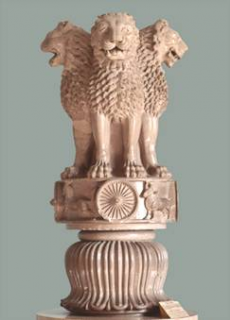
The Pillars of Ashoka are a series of columns which were erected throughout India during the reign of the Ashoka the Great in the 3rd century BCE. An emperor of the Maurya dyntasy (322 BCE-185 BCE), he had the columns transcribed with edicts proclaiming his philosophy, and adherence to the Buddhist faith.
Ashoka descended from Chandragupta Maurya, the founder of the Empire, and ascended to the throne in 269 BC. At first he ruled tyrannically, harshly dealing with anyone who opposed him. In 262 BC he began a war against the feudal republic of Kalinga, located on the east coast of the Indian subcontinent. It turned out to be one of the bloodiest battles in world history, with the Daya River beside the battlefield turning red with the blood of the slain. As many as 250,000 people may have been killed. Witnessing the destruction and knowing he was the cause, Ashoka experienced extreme remorse, and vowed never to wage a war of conquest again. He converted to Buddhism to find a more peaceful way of life.
Ashoka didn’t make Buddhism the state religion, but he did spread it widely through his edicts. The edicts were written in the Brahmi script, one of the oldest written systems used in the Indian subcontinent. Today only nineteen of the pillars survive, but originally there were many. They were placed in strategic sites, at Buddhist monasteries and places of pilgrimage, near border cities and trade routes. Five of the pillars of Ashoka, two at Rampurva, one each at Vaishali, Lauriya-Areraj and Lauria Nandangarh possibly marked the course of the ancient Royal highway from Pataliputra to the Nepal valley.

The columns average between 40 and 50 feet in height, and weigh up to 50 tones each. The columns are carved from two types of stones: some are made of spotted red and white sandstone from the Mathura region, and other are buff-coloured hard sandstone with black spots from the Mirzapur region, both located in the northern district of Uttar Pradesh. Because the carving of the columns is so uniform, it’s believed that they are all the work of the same craftsmen. This means that the stone had to be dragged, sometimes hundreds of miles, to where they were erected.
The Muslim Mughal Empire ruled India from the sixteenth century, and believed that depicting living beings was blasphemous. Consequently, only six columns with animal capitals remain, as they were the target of Muslim iconoclasm, or destruction. The most iconic of the Ashoka pillars is the one with a four-lion capital, or top, at Sarnath (pictured). Sarnath is a very important Buddhist site, as it’s where the Buddha gave his first teachings after attaining enlightenment. The column remains in place, but the capital itself has been moved to the Sarnath Museum for safe keeping. The four lions on the capital stand back-to-back, and symbolise power, courage, pride and confidence. An image of the lions has been adopted as the National Emblem of India, while an image of the Dharma chakra wheel below them has been placed in the centre of the Indian flag.
Images: https://upload.wikimedia.org/wikipedia/commons/thumb/0/0a/Asokan_Pillar.JPG/800px-Asokan_Pillar.JPG https://upload.wikimedia.org/wikipedia/en/2/2c/Sarnath_Lion_Capital_of_Ashoka.jp

0 Comment:
Be the first one to comment on this article.